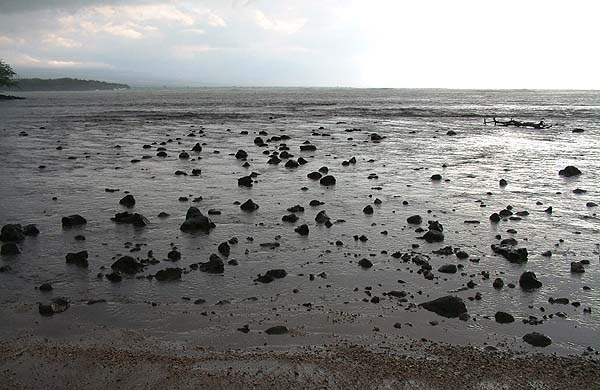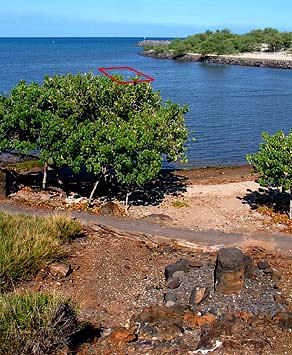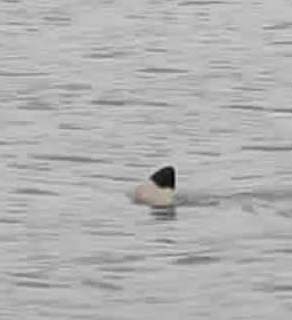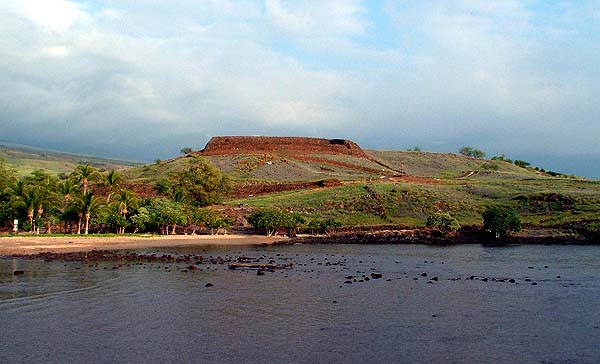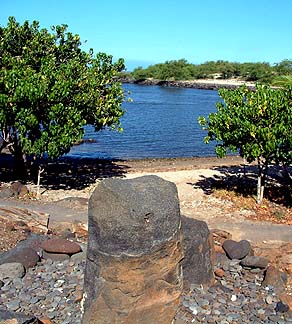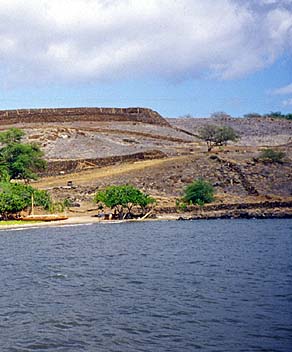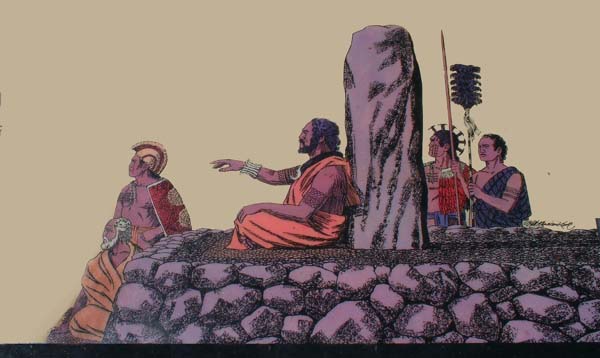 |
 |
 |
|||||
|
|
|||||||
| |
|
|
|
"I remember them telling us," Ku‘ulei begins, "that they had a temple in the ocean. That Pu‘u Kohola heiau was the main temple, then below that is a sub-heiau, a smaller temple [Mailekini], and then in the ocean that there was a temple too. And when the tide would come in, it would sink under water. And that’s where their sacrifices would be laid so that the shark gods could have them."
|
||
| |
||
This temple, Hale o Kapuni, is mentioned by Fornander in the story of Lonoikamakahiki, as the place where "all the chiefs...encamped," and was located "immediately below the temple of Pu‘u Kohola and Mailekini at Kawaihae" (Fornander 1917 (4): 324; cited in Kelly 1974: 27). "Theophilus Davies arrived off Kawaihae in 1859," Greene writes in her study of the area, "he recorded passing in the water beneath a 'sacred enclosure' about twenty yards square and formed by a massive stone fence five feet high (probably Mailekini Heiau). A large stone formed its altar, he said,
|
|
|
“They had the heiau there,” Lala says. “It’s buried though. We used to pass there with the boat all the time. At low tide, it comes up out of the water. It’s a pile of rocks that comes up, with kind of a little slab on top there. They sacrificed people, as I recall [laughs]. A lot of shark coming down. A lot of sharks. But they don’t bother us.” "I remember going there as a kid," Ku‘ulei recalls. "We would go there to crab. I remember the sharks and their baby sharks, three, four feet long. And lots of them. I mean, sometimes we’d come out of the water and my dad goes, ‘Oh that’s not good. Lot of sharks in the water.’ "So we’d come out. But even during the daytime, in the evening, afternoon you’d go and you watch and you see their fins. The mother sharks come there because they like the muddy water to have their babies there. So it’s very comfortable for them; the murky water is protection. Pelekane Bay has always got sharks like that in there."
|
|
|
|
|
“We used to go there and watch the shark heiau," Lani remembers. "There was a place where you can sit, made out of rock, and the shark heiau was there. I asked my mother, ‘what is all this for?’ ‘Oh, but the sharks used to come here. Hawaiians worship the shark.’ I said, ‘Worship the shark? Why would they want to worship shark, when that thing could eat a human being if they fell in the water?’ She said, ‘If you worship the shark, they won’t eat you.’ So they believed. "I was afraid of sharks. Even the word frightens me. And I was afraid of that place, very scared of it. Because one time I was sitting on the beach, and I was looking out there and I said, ‘What is that out there?’ It was a shark, and I tell you, I was afraid to even put my finger in the water.”
|
||
|
|
||
"The black tip sharks down at Pelekane," Papa explains, "they’re seasonal. Different seasons, they come in plenty—for spawning, mating, whatever. But you don’t see them every day. See, they move, like any other things. They don’t live here. Because of a certain current that brings them in there and maybe certain stuff they dump in the water. Like they used to ship cattle there, so all that cattle manure and stuff like that gets in the water, from the cattle. And then when they wash down on the ship, all that flushes down into the ocean. So you get them. But they don’t stay here. "For a long time now, I haven’t seen any like I used to see. Any time I drove, I used to see at least one or two. Before the harbor was built, the bay was all the way inside. But then they narrowed the space that they had. Before, it was the whole area, so the sharks could go all over. But when they made the harbor, they made a narrow space, so they only come in one area."
|
|
|
Hale o Kapuni is seen by some as an extension of Pu‘u Kohola. “There is an interruption where the road is," ‘Ilima remarks, "but actually the heiau goes right into the ocean. True, I think the water has receded a bit with all that’s going on there." Greene cites a study by anthropologist Lloyd Soehren, which states that, as children, older residents of the area remembered seeing the heiau rising about two feet above the water. One person remembered a channel leading into a larger area within the temple where the bodies were placed for the sharks (see Greene, 1993: history7e.htm). This aquatic heiau is no longer visible. Some say that silt from the nearby coral flats of the new harbor have covered it over. Others suggest that the various tsunami that have hit Kawaihae have broken it up and scattered its rocks. An interview conducted in 1978 with an elderly resident said that during World War II, amphibious equipment landed in the water and on the beach and may have obscured or scattered remains of the heiau (Greene, 1993: history7e.htm).
|
|
|
|
|
On the shore above stands a stone, Pohaku o Alapa‘i ku palupalu mano, "the rock of the chief named Alapa‘i of the one who puts the human shark bait out." This chief served under Kamehameha and was also known as Alapa‘i-malo-iki. Kamakau writes that he and another chief, Ka-uhi-wawae-ono, "were murdering chiefs who did not keep the law against killing men, but went out with their men to catch people for shark bait. If they found a man or even a woman out at night they would kill him and keep the body until it decayed and use it for shark bait" (Kamakau 1992: 232).
|
||
|
|
||
The rock is also known as Kikiako‘i. Kamakau used this name to refer to the place where Mailekini heiau stands. Desha refers to it in his version of the death of Keoua: "Keoua's canoe moved in near the landing place which was that deep harbor at a place called Kikiako‘i and Haleokapuni, a deep channel where a small schooner could enter." Desha then recounts that "Keoua's body was taken and placed in the hands of the kahuna of the heiau of Pu‘u Kohola. When they were finished with their work, we was offered up to consecrate that heiau....His body was taken and baked in the imu on the Kohala side of the heiau Mailekini. Kikiako‘i is the name of that imu in which the body of Keouaku‘ahu‘ula was baked" (Desha 2000: 332-4).
|
Kikiako‘i.
|
|
"The stone was set in its present concrete footing in 1935," Marion says, "but the top was broken off shortly thereafter by a truck which backed into it." Greene cites local lore that "the driver of the dump truck that backed into this ancient stone and broke it died later that day in a car accident" (Greene 1993: historyn.htm#7144). Today this site is commonly refereed to as "Kamehameha's chair," though as historians have noted, it would have been more of a leaning post, since Hawaiians did not use chairs but sat on the ground. ‘Ilima says that the real "chair" is actually in the water: "We knew about the chair right there in the ocean, because we would paddle our canoe and we’d see those baby sharks. It’s still there. "I don’t think anybody has really seen the chair, unless you’ve actually gone into the water. It’s in the water, because that’s where he fed the sharks actually sat on it. I’m not sure if the tide has been that low where you can actually see the chair."
|
|
|
|
“Some people have gone and actually sat on it, which for the Hawaiians is very disrespectful. I know it’s there because my Dad used to fish around there. He tells us that it’s there, and I think my nephew actually swam there, and they saw this huge rock formation that looks like a chair. And maybe the ‘aumakua kind of protect it and do not allow people to see it. Because you never know what they might do. They might go in there and take pieces of it."
|
||
|
|
||
| While this group of sites occupies the lowland of Kawaihae, another settlement thrived in the uplands, known as Kawaihae Uka.
|
||
|
|
||
|
|
|
|
|
|

|
| Kawaihae Home | Map Library | Site Map | Hawaiian Islands Home | Pacific Worlds Home |
|
|
|
|
|
|
|||
| Copyright 2006 Pacific Worlds & Associates • Usage Policy • Webmaster |
|||
